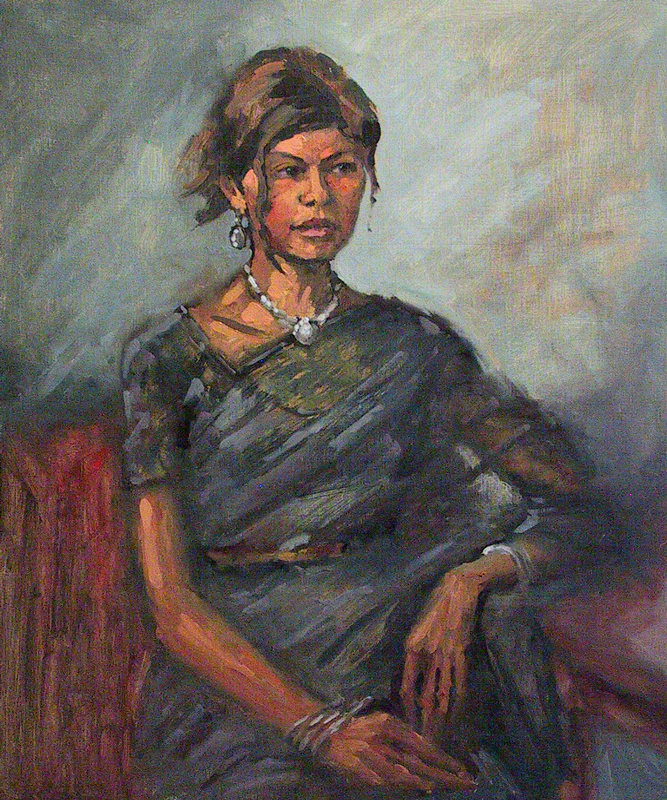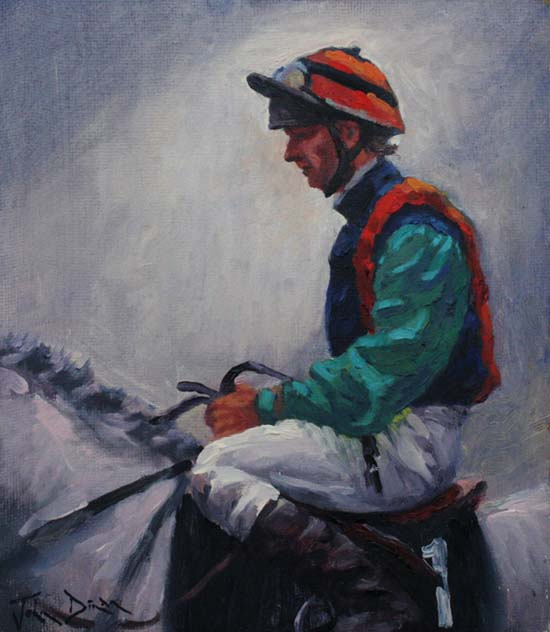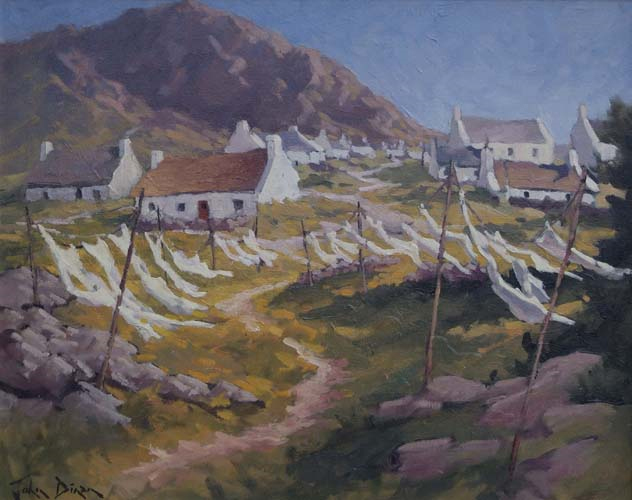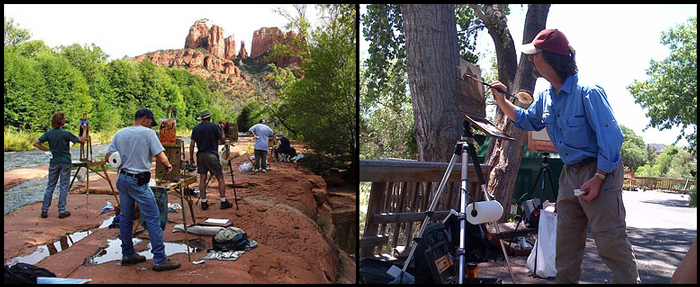Archived Comments
Enjoy the past comments below for The karma of art…
I would pose for a portrait at no charge if I knew the artist was decent and the work good. Being upfront seems to steam out the wrinkles and unfold the deals; no reason to avoid communication which is a form of creative imagination. I’m sure John Dinan will learn to cough up a little now and then and get his words straight — neither he nor his study has to “feel” uncomfortable or have a problem. BTW nicely executed work!!
It seems to me that if someone asks you to do their portrait then
they are your client. BUT, if you ask someone to sit for you then that person becomes your model. They are now working for you. Does this not mean that they should be paid for their time in some form? You did say that you needed to paint that particular face. I assume then, that there is some characteristic of that face that you need to study and master in order to advance your future capabilities.You study at school, you pay for it. Study under a master, you pay for it. Therefore, study a face, pay for it. Clif Dawson. clifdawson.caI agree with you Clif. When John said he asks these people to sit for him so he can paint their portrait and then wanted to know how to get them to pay him, I was a bit confused. If you see someone walking down the street or you see someone sitting at a table outside a sidewalk cafe and you feel you just have to paint them, you don’t tell them that they need to pay you for the privilege of sitting for you.
This reminds me of those photographers that wander the casinos of Las Vegas, snap your picture with your sweetie and then try to guilt you into buying the photos. If I commission an artist to paint my portrait then yes, I will expect to pay for it and full price at that, just as if I ask a photographer to shoot some shots of me I expect to pay for those, too. When I ask a model to pose for me so I can shoot some reference photos to be used in my paintings and drawings, I pay her for her time. Her time is just as valuable to her as mine is to me.Yup, I agree with Clif and Dave. I thought I’d misunderstood when I read that you would even consider asking a model to pay for your painting of him! You pay him, or at least offer to.
If you plan to sell him the painting you “needed” to do of him, you must say so before you start. But you’d probably find potential models disappearing like the snow in last week’s thaw… And it’s not as if you have to pay income tax on your earnings as an artist in the republic… unless they’ve changed that now?I agree with those above who are saying that this artist should not expect his model to pay. I too was confused when I read that he felt the need to paint the face, asked the person to sit and then wanted them to pay him??? Sorry, but this is wrong on so many levels. If anything, the model should be paid for his/her time given to the artist to improve his skills.
The standard practice where I live is that when you ask someone to sit for you, you pay them the going rate, which is usually $20/hr. $30/hr if nude. Sitting still is effort and time on the part of the model. If the painter is well-known, sitting for them may be considered a privilege and the model may offer to sit for free in exchange for the notariety. Usually the artist still gives them something–a small painting, study for the painting or copy of the work. When someone hires the artist for a portrait, they pay. I’m glad we all agree. John Dinan-if it is not the practice in Ireland to pay models for their time, perhaps it’s time to change that practice. You will be thought of as generous, a source of employment, and will have interesting faces showing up on your doorstep! If you can’t afford to pay, you can offer your time to them in exchange. A drawing lesson, a meal, something!
I consider myself a professional artist, although I do not make a living (nor could I) through my art.
I want very much to respond to this article, The Karma of Art. I strongly believe in this I concept. I often will give a painting away to someone who has posed or requested a painting when I know they are unable to pay the price I would usually attach to it. I would rather do this than ask a more meager fee. It becomes a gift of my soul to do so. This is so ingrained in me now that I see myself as someone who is here to provide a sense of presense in others appreciation in my work… a feeling of connection in the peice that has given them a part of their own soul to look at. This is my purpose now, in the later stages of my life. It is a gift to me as well.You ask: you pay the sitter for their time and their image. They ask: its a commission, and they pay. Easy.
Clif has it right. ;O)
Since most of my paintings, are either people or animal portraits, I find that if I do a “give-away”, which I often do for a fundraiser for a specific cause, either animal shelters or children’s hospitals, I will get more than the usual commissions in return.
What you freely give, good or bad, returns to you in some fashion, 10 fold.I may be soft in the head, but as I understand this letter, the artist is uncomfortable asking the sitter to pay for a portrait that the artist instigated, is this correct? If so, the audacity of that artist! what?! It would be akin to a landscape painter painting a farmers field, then knocking on the farmers door asking to be paid. If that is how things work, I’ve been doing it all wrong all these years. It hurts to think of all the income I’ve lost by not demanding to be paid by the owner of a field, or a face.
As I usually do some kind of preparatory drawing before embarking on a portrait, I give the model (or the model’s owner, if the model is not human) the drawing, or I offer to pay the model the going rate. People usually prefer the drawing to the cash. Animals don’t seem to care one way or the other.
As others rightly say: this is a business deal and the sitter ought to be paid unless it is a commission. This seems to me to be a no-brainer.
If John asks someone to sit for him and then expects that person to pay him, then what he’s doing is soliciting for work. It’s no better or worse than someone going down the street and knocking at every door to find someone willing to pay him to paint their house, or clean their gutters. Surely, the price needs to be discussed before the work proceeds. If however, he wants to paint someone because they’re interesting, then HE’s the one who should be offering to pay them. The purchase of the painting is another matter entirely but he should not expect his sitter (employee) to be willing to pay the price of the painting. All he was asked to do was sit for a painting.
When I first read John’s letter I couldn’t quite figure out who was paying who. I could not imagine asking someone to sit for a painting and then asking them to pay for it. I really hope I’ve misunderstood that. If I find someone I’d like to sculpt I either pay for their time, if they’re a professional model, or I offer them a plaster copy of the piece. If they ask to purchase the piece, that’s different but I’d never ask them to.
Dear Robert,
We have to get our inspirations from somewhere. If you are a landscape artist, then you need to study landscapes. if you paint portraits, you need a subject. If you happen to score a commission where people sit for you, then more power to you. Thats the golden project and they don’t come around very often. I would say the best thing to do if being a portraiture artist is your thing, start with friends and have them sit for you. Make it fun, offer lunch or some wine and make sure you require only a small amount of their time. Why not advance to taking photographs and working from pictures. This way you can capture what you want without having the subject sit for hours on end. People would be flattered to be the subject of an artist, but when it requires a great deal of time it become waning… Then when you are rich and famous, you can pick and choose your subjects and have them sit and wait for you for hours while you decide when you are going to paint. Dare to dream…John FerrieI think model releases are extremely important, whether it is a commission or hiring a model. There are lots of examples in art business books or on line. I use one that states among other things, how much I am paying the model for sitting and what I might plan to do with the resulting painting. I like to know ahead of time if a model doesn’t want their image in an art show, a magazine add, or on the web, etc.
Good point, Bonnie! You should have your model’s permission to display his (recognizable) image publicly, unless he is one of a crowd or in a similar public group. And it’s just good manners and fairness, not to mention good business practice, to get payment and other details down in writing first.
I am a pastel painter and do many portraits of people and animals.
I do as you suggested and give the portrait away or charge full price. Many of the portraits are from life with models. It makes me feel good when a year or so later I find that it is hanging over their fireplace. Lately I am finding portraits of children and animals ( horses, bulls, cattle, and dogs etc. ) can bring even more joy than a portrait of the person. My Grandmother and husband’s Uncle were artists also. I find that the history of artists paintings in the family live on from generation to generation and inspire the youth in the family to expand their horizon and draw and paint.I live in Cumbria, England and our Art Society has a Portrait group which meets fortnightly. Our sitter is invited by our host-hostess and is not paid but expected to enjoy the social occasion. Some of the more proficient painters are happy to give the sitter their work after having taken a copy for their own folio. As most of us work in pastel and do not have need to keep the work this is a very satisfactory outcome for all.
Am surprised that an artist would expect payment, when he/she is the one who has “asked” someone to pose/model. Modeling is tedious and laborious. Whenever, at my request, someone poses or models for me, they receive compensation for their labor. Should the model want a copy of the work, then I receive compensation, or give a study as a gift, depending on the model’s ability to pay. When a work sells and I still have contact with the model, I will share a percentage of the net proceeds so we both benefit from a job well done. The good will expands and lends mutual respect…
Great story. I just donated two of my pastels to an organization for their silent auction and I was told that large crowds of the attendees stood around my two paintings and made wonderful comments about them…and then they swiftly were sold at decent prices…maybe more than I’d ever get from them being on the art association’s walls in my town…
The information was more important to my psyche than if I were given a check for each of them. I sometimes can make more money in the stock market than I could ever get for my artwork… and the day after the auction was held, this new market started it’s upticking and I felt that was my karmic gift back to me….I thought that the problem wasn’t with the modeling fee, but that the artist did not want to sell the portrait, while the model asked to buy it, although the artist knows that the model can’t afford the full price. That’s something that happened to me. It helps to be very clear up front what is going to happen to the painting. If the model likes it, I always give them a print.
In my experience, portraits of musicians tend to build karma quickly. I’ve had one that was exhibited, then bought and hung in a bistro, then given to the musician who was the subject, then abandoned in a mysterious disappearance. It was finally returned to me. (I am still getting commissions as a direct result of the original watercolor portrait.) Now it hangs expectantly over our dining table, no doubt awaiting his next adventure. Weird.
I just want to thank you for the wisdom and enrichment that your messages provide to artists like me. They make us feel connected to a community, when the risk is that we (in the midst of the struggles and anguish of the creative process) can feel isolated and bereft of support which is based on knowledge and understanding, the kind that comes only from peers and from mentors.
I’m really not sure about this. I think he might be missing the point of doing what you love!
As an Artist, I just want to make art. If no one will pay me at the moment to make art for them, I’ll make art for me.Look Robert put your normal prize for your work, tell them you may this count, some time you can give in 3 part or 2 paiments but don’t low to much the prize because you low your Art. I hop your understand What I try tell you.
roma4lectura@yahoo.comAh the Karma of the Painting! Giving away and getting back. Last winter I did a small, 11 X 14, Painting/Collage of Trees and Hills inspired by the Olympic venues in CA. My neighbor was so enamored of the piece that he offered to trade or barter for it. He
is a talented wood carver and had a small bird carving to offer. How could I say no? I will always know that he is enjoying that small slice of Winter and I am remembering the story of the Bird carving. That’s Karma.Although my main art form is abstract, I do portraiture as well, both for commission and for study (I like to try different techniques and media). I regularly ask people with interesting faces to pose for me, and offer them a print of the finished image, as I keep the original. I also have them sign a model release so I can use the portrait for various venues, such as calls to artists, and on my website. This has worked out well – the sitters are flattered, they have a print of the work, and I have my models and get to practice! I don’t plan on selling these pieces, so it works for everyone.
Huh? I thought that artists pay the models. That goes back to Van Gogh who struggled to come up with the money to pay his sitters.
Seems simple to me, if these are faces he needs to paint, then he needs to ask them to model for him, and to pay them the going rate. That leaves him free to sell it wherever he wants to. If, when the painting is finished, the model expresses an interest in buying it, he can sell it to them at the regular price, minus the modeling fee. This should all be disclosed up front, before the painting even begins.
If people come to me to have their portrait done then I charge. If I go to them I tell them two things (if they are willing to sit). YOu can have the painting if you like it on one condition . . .that IF I need it for a show you will “lend” it back to me. Sometimes they don’t like it and I keep it. When they DO take it I make sure I have all the contact info about them. Admittedly, I don’t go traipsing over half the globe so my sitters are all “locals”. But it works for me.
He says he deserves to be paid for his work, so do his practice subjects. Give some back is great advice…
The sitter should be paid by the hour. It is $10 an hour here in the States. It is your business arrangement. The product is not given away or sold below your rate.
WOW!?! – people pay you to sit for them? I always pay the people a modeling fee. Then have them sign a release. What am I missing here?
corsetti@corsetti.comFrankly, not to put a fine point on it, I think it is arrogant to think someone who is not a friend or family member should sit for you for nothing. There is no reason you should think you are such wonderful a painter that they should be so honored. Negotiate a fair fee- that way both of you are happy. Pay them.
I used to be in need of girls to model clothes for me, I knew that some of them would have been happy enough to do it for free since they used to find it fun and give them free exposure. However the best thing to do is talk about it before and just tell them that you need a sitter and you usually pay so much per hour but if they are happy to do it for free they would say so then. A small thank you present however is always welcome by one and all.
It was December 8, 1980 when I arrived at my studio and turned on the news. John Lennon had been shot! My goodness the world’s John Lennon had just left the earth. I think many of us felt that our younger selves had something taken away from us that night. I was not doing celebrity portraits at the time but felt compelled to put my thoughts on paper. I did a quick sketch of John looking pensive with his round glasses and head cocked and hand holding his chin.. I simply titled it “Goodbye John December 8,1980”. A few years later I gave the piece away and forgot all about it. Recently I was contacted by someone who now owns the portrait. They wanted to know how much it was worth. My answer was it is worth whatever you paid for it because you liked it so much.
John Dinan should listen to his feelings of discomfort in asking for payment from the model for a portrait which he initiated. If it were a commissioned work, the relationship between sitter and artist is clear. If the artist asks someone to pose, the artist certainly owes the sitter something in return. Robert, why would you be soft in the head for suggesting this? Why would anyone give up their visage, their time, and their whole persona for the artist to use without any reward or recognition? Do we artists think that the act of painting that person is payment enough? Offering the sitter an exclusive giclee of the portrait is a reasonable compromise, though, to giving the painting away. I think asking for payment from the sitter is really not cool.
If artists ask someone to sit (i.e. work) for them, they should expect to pay standard model fees or some other mutually agreed exchange, especially when these are subjects they need or want to paint. If a person orders a portrait, the boots on the other foot and thats business. You are providing a requested service for them. Even Picasso gave portraits to people he wanted to paint: vid. Sylvette D., 1954, a girl he saw in passing, and whose profile attracted him. He asked her to sit for him, started realistically, then made several abstracted studies. She was allowed to choose one. Thats a mutually agreed exchange and one Im sure her descendants, if any, are very pleased with!
John, I’m puzzled as to why your portrait sitter’s time would not have the same value as your own time… Is your discomfort because at some level of your psyche you understand that fact? The model is also a skilled worker possessing special gifts that you recognize and want to capture in paint. Commissions are a different entity that could evolve out of someone’s seeing your work. The model is, indeed, a collaborator in your process and
deserves compensation. There is not a finite amount of reward for beauty as Robert Genn has so diplomatically offered in his response to you. I am an an artist and sometimes model,I’d like to thank all my fellow artists for such a wide range of helpful comments to my original query. In my defence I must state that I have never asked sitters to pose and then ask them to pay – that sounds like an ‘ambush’ to me; I think that impression came about through the edited version of my original query. Artists spend so long painting alone, isn’t it great to have such a forum for practical advice – thank you all again. John Dinan
Asking someone to sit is entering into some sort of participatory agreement with them. While a friend might agree to sit without compensation, or even require a discussion of such, a casual acquaintance or relative stranger will not have sufficient understanding of the transaction. It should be established in advance if there is any sort of consideration or compensation involved. It can be anything the painter and model decide, from a proferred mocha latte to a discount on a picture, but to be fair, the arrangement should be well understood on both sides, then no one has reason for qualm or complaint.
I dont understand why so many people commented with such negative feelings towards the artist. I totally understand John Dinan, this happened to me several times. I ask someone to sit for me and offer a regular modeling fee (I pay $20 per hour), but if they are not professional models, they often decline the fee saying they would be glad to sit with no compensation. Friends and neighbors often do that. During the session, some of them ask to buy the piece, speculating its worth to be way (way, way) below my regular prices. I get strong pointers that they would like to be given it for free. The feeling of discomfort is about weather I part with the piece, so I cant use it to do a studio work from it, basically wasting this whole session time and material. At that point I offer a print for free, but the sitters often get in the mood of you think you are so good which is very uncomfortable. But, dealing with people isnt simple, so this is a part of our business. This may be avoided by insisting that the model takes a fee and explaining that I need the original for my studio work, make it clear this is very important for you, and thats why you pay models to sit for you so that they dont waste their time. If the model asks for the price of the finished work, just say what it is. Sometimes they are shocked because they undervalue art but there is nothing we can do about that. Another thing you can do make a few quick sketches as a warm-up, and give them to the model for free. The worst thing you can do if they didnt take the fee, is to sell the piece to them for a small amount then it appears as if the model is paying you to sit for you which is probably why many people commented negatively. If the model turns out to be a serious collector and wants to buy for the full price, just deduct a very generous modeling fee from it thats the best case scenario, a win-win!
I haven’t read all these entries on possibly themost entry-inspiring topic so far, but could not the artist make good quality giclees of a successful portrait he’d solicited the model to pose for, adn give that as well as/instead of the siting fee? Then the original can still be sold for a high price and the model has the image. I haven’t figured out how to get my name entered: I am Frances Stilwell, corvallis Oregon. How does all this apply to the stranger you see on teh street and you take his photo to later turn it into a lively portrait?
I love the one of the woman putting on her makeup. That one really is wonderful, John. Nice work!
I hope John has learnt a very valuable lesson here. Of course everyone’s time is valuable not just the artists. you wanted it you pay for it. to give is better than to receive unless it’s a pure business contract.
i think quiet morning is a stark , highly effective painting…simplicity is the power. great job!!!
Robert:
Your painting “Quiet Morning” is fabulous !The pressure to show less thanthe best comes from our shared difficulty in producing enough work. A mentor from years past had the perfect solution. For every good image idea there are at least 5 variations in scale color or viewpoint that will multiply our out put. One will stand out to save back for our own collection, competitions or for museum donations to make our name, the rest will supply at least 4 additional one man shows and provide more than enough work. Try it! It has worked for me for 25 years!
I am amazed to enjoy this topic and so many diverse opinions I run a life drawing studio from my house and Ihappen to find an interesting idea for a portrait or a full lenght drawing and so alerting my group on this kind of a model thaqt we choose and we agree to pay them exactly what we pay the usual life model . WE cashed in recently by asking a Mexican singer to come and pose for the Friday class . She was initially so worried that I was insuiniating that she would pose without clothes .I at once reassured her that she could pose in her costume form Spain and all of her usual fans and reguilai and she surprised us by agreeing and holding poses sowell that we all aenjoyed this ind of a model…. we paid her what we usually pay our usual models. Shortly after this eventI was able to recommend that she and her partner would entertain the Folk group in Steveston to her kind of Spanish gypsy music and it was ahuge success concert .Our artist group were invited to show our paintings from the life drawing class to complement this woman’s singing it was a win win …no money sold on the portraits just lots of good vibes Adrienne Moore
IT WAS AMAZING.I LIKE IT VERY .. VERY MUCH..
Wow, Luann, I went through exactly the same feelings. Thank you for sharing your experience. I don’t feel so alone. (At the beginning, it was even hard to call myself an artist.)
I, too, really like your work. I’m a big fan of the Lascaux Cave painting and suspect you might be too. If you haven’t heard of them, you might want to google it. Thanks again.In response to John Dinan, having spent time on both sides of the easel, the answer seems clear to me. When someone asks you to paint something for them, you discuss what they want and the cost to them. When you ask someone to pose for you, you pay them. Perhaps the confusion arises because he’s painting portraits? If he was drawing the figure it might be more obvious. You hire a model at the going rate. Since he’s not working with professional artist’s models, but instead, his neighbors, at the onset (as you yourself wrote) you pay your model something they feel agreeable to. If they aren’t comfortable being paid money, you could offer a meal or something comparable to the money you would pay a model. Artists never concern themselves with what an artist’s model might think when they sell their painting. So, pay your models and keep your work. If your model wants to buy the portrait after they’ve been paid, then you have them pay you for it. And if you ask a different price for it than you usually get for a commissioned portrait, that’s the sort of thing you work out per ‘customer’. As a gallery manager, I sometimes arrive at certain compromises or ‘deals’ with buyers, with the artist’s permission. So if you pay your model with a good meal, they might buy their portrait from you for a bucket of oysters or a bushel of apples or a boatload of fish. Just as fellow artists will sometimes trade one painting for another.
Ha there ever been a forum as good as this? Thanks, Robert, and all the gnomes at Painters Keys. Happy new Year!!!!!


Long Autumn Shadows oil painting, 36 x 48 inches by Gordon Lewis, Regina, SK, Canada |






















You’re absolutely right about some people needing something more than you need the money, from kind words to a thoughtful, “here, take it,” given from the heart. “What goes around, comes around” works both ways.
Your work is stunning.